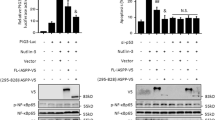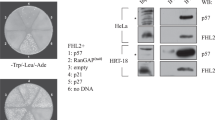Abstract
Nuclear factor κB (NF-κB) is a transcription factor that controls the expression of many cellular and viral genes. The p65 (RelA) subunit plays a critical role as a transcriptional activator and recent observations have highlighted its role in the control of apoptosis. Here we report that 53BP2, a protein previously identified by interaction with wild type p53 and Bcl-2, also binds to p65 in a yeast two-hybrid system. This specific interaction was confirmed by pull-down assay in vitro and by a mammalian two-hybrid assay in vivo. We observed that full-length 53BP2 fused to GFP had a punctate distribution in cytoplasm, predominantly in perinuclear region whereas the N-terminal 53BP2 localized in cytoplasm and C-terminal 53BP2 localized in the nucleus. Furthermore, we found that overexpression of GFP-53BP2 induced apoptosis in transiently transfected cells. Neither the N-terminal nor the C-terminal of 53BP2 fused to GFP induced cell death. Interestingly, co-transfection with a p65 expression plasmid significantly inhibited 53BP2-induced cell death. The previous findings that 53BP2 bound to p53 and Bcl-2 together with our present observations suggest that 53BP2 may play a central role in the regulation of apoptosis and cell growth.
This is a preview of subscription content, access via your institution
Access options
Subscribe to this journal
Receive 50 print issues and online access
$259.00 per year
only $5.18 per issue
Buy this article
- Purchase on Springer Link
- Instant access to full article PDF
Prices may be subject to local taxes which are calculated during checkout








Similar content being viewed by others
References
Baeuerle PA and Baichwall VR. . 1997 Adv. Immunol. 65: 111–137.
Baldwin Jr, AS. . 1996 Annu. Rev. Immunol. 14: 649–683.
Bar-Sagi D, Rotin D, Batzer A, Mandiyan V and Schlessinger J. . 1993 Cell 74: 83–91.
Beg AA and Baltimore D. . 1996 Science 274: 782–784.
Bellamy CO, Malcomson RD, Harrison DJ and Wyllie AH. . 1995 Sem. Cancer Biol. 6: 3–16.
Fields S and Song O. . 1989 Nature 340: 245–246.
Gorina S and Pavletich NP. . 1996 Science 274: 1001–1005.
Gottlieb TM and Oren M. . 1996 Biochim. Biophys. Acta 1287: 77–102.
Graeber TG, Osmanian C, Jacks T, Housman DE, Koch CJ, Lowe SW and Giaccia AJ. . 1996 Nature 379: 88–91.
Grimm S, Bauer MKA, Baeuerle PA and Schulze-Osthoff K. . 1996 J. Cell Biol. 134: 13–23.
Hardin JA, Hinshita F and Sherr DH. . 1992 Toxicol. Appl. Pharmacol. 117: 155–164.
Helps NR, Barker HM, Elledge SJ and Cohen PTW. . 1995 FEBS Lett. 377: 295–300.
Hollstein M, Sidransky D, Vogelstein B and Harris CC. . 1991 Science 253: 49–53.
Iwabuchi K, Bartell PL, Li B, Marraccino R and Fields S. . 1994 Proc. Natl. Acad. Sci. USA 91: 6098–6102.
Iwabuchi K, Li B, Massa HF, Trask BJ, Date T and Fields S. . 1998 J. Biol. Chem. 273: 26061–26068.
Lippincott-Schwartz J. . (1998). In: Green Fluorescent Protein-Properties, Applications, and Protocols. Chalfie M and Kain S. (eds).. Wiley-Liss: New York pp. 243–268.
Klefstrom J, Arghi E, Littlewood T, Jaattela M, Saksela E, Evan GI and Alitalo K. . 1997 Cell 16: 7382–7392.
Martin SJ, Reutelingsperger CP, McGahon AJ, Rader JA, Van Schie RC, LaFace DM and Green DR. . 1995 J. Exp. Med. 182: 1545–1556.
Michaely P and Bennett V. . 1993 J. Biol. Chem. 268: 22703–22709.
Miyashita T, Krajewski S, Krajewska M, Wang HG, Lin HK, Liebermann DA, Hoffman B and Reed JC. . 1994 Oncogene 9: 1799–1805.
Naumovski L and Cleary ML. . 1996 Mol. Cell. Biol. 16: 3884–3892.
Nolan GP, Ghosh S, Liou HC, Tempst P and Baltimore D. . 1991 Cell 64: 961–969.
Okamoto T, Sakurada S, Yang J-P and Merin JP. . 1997 Cur. Top. Cell. Regul. 35: 149–161.
Pines J. . 1995 Trends Genet. 11: 326–327.
Prives C and Manfridi JJ. . 1993 Genes Dev. 7: 529–534.
Ruben SM, Dillon PJ, Schreck R, Henkel T, Chen C-H, Maher M, Baeuerle PA and Rosen CA. . 1991 Science 251: 1490–1493.
Sachdev S, Hoffmann A and Haainak M. . 1998 Mol. Cell. Biol. 18: 2524–2534.
Sakurada S, Kato T and Okamoto T. . 1996 Int. Immunol. 8: 1483–1493.
Sambrook J, Fritsch EF and Maniatis T. . 1989 Molecular cloning: a laboratory manual. Cold Spring Harbor Laboratory, Cold Spring Harbor, NY.
Sato T, Asamitsu K, Yang J-P, Takahashi N, Tetsuka T, Yoneyama A, Kanagawa A and Okamoto T. . 1998 AIDS Res. Hum. Retrovir. 14: 293–298.
Selvakumaran M, Lin HK, Miyashita T, Wang HG, Krajewski S, Reed JC, Hoffman B and Liebermann D. . 1994 Oncogene 9: 1791–1798.
Siebenlist U, Brown K and Franzoso G. . 1995 In: Inducible Gene Expression Volume 1. Baeuerle PA. (ed.).. Birkhauser: Boston pp. 93–141.
Sparks AB, Rider JE, Hoffman NG, Fowlkes DM, Quilliam LA and Kay BK. . 1996 Proc. Natl. Acad. Sci. USA 93: 1540–1544.
Strasser A, Harris AW, Jacks T and Cory S. . 1994 Cell 79: 329–339.
Thukral SK, Blain GC, Chang KKH and Fields S. . 1994 Mol. Cell. Biol. 14: 8315–8321.
Wang C-Y, Mayo MW and Baldwin Jr AS. . 1996 Science 274: 784–787.
Wolter KG, Hsu Y-T, Smith CL, Nechushtan A, Xi X-G and Youle RJ. . 1997 J. Cell Biol. 139: 1281–1292.
Wu H and Lozano G. . 1994 J. Biol. Chem. 269: 20067–20074.
Wu M, Lee H, Bellas RE, Schauer SL, Arsura M, Katz D, Fitzgerald MJ, Rothstein TL, Sherr DH and Sonenshein GE. . 1996 EMBO J. 15: 4682–4690.
Yamabhai M and Kay BK. . 1997 Analyt. Biochem. 247: 143–151.
Yang J-P, Ono T, Sonta S, Kawabe T and Okamoto T. . 1997 Cytogenet. Cell Genet. 78: 61–62.
Acknowledgements
We thank S Inuzuka, M Suganuma and T Tetsuka for helpful suggestions. This work was supported by grants-in-aid from the Ministry of Health and Welfare, the Ministry of Education, Science and Culture of Japan and from the Human Science Foundation. J-P Yang is a research fellow of the Japan Society for the Promotion of Science.
Author information
Authors and Affiliations
Rights and permissions
About this article
Cite this article
Yang, JP., Hori, M., Takahashi, N. et al. NF-κB subunit p65 binds to 53BP2 and inhibits cell death induced by 53BP2. Oncogene 18, 5177–5186 (1999). https://doi.org/10.1038/sj.onc.1202904
Received:
Revised:
Accepted:
Published:
Issue Date:
DOI: https://doi.org/10.1038/sj.onc.1202904
Keywords
This article is cited by
-
iASPP-Mediated ROS Inhibition Drives 5-Fu Resistance Dependent on Nrf2 Antioxidative Signaling Pathway in Gastric Adenocarcinoma
Digestive Diseases and Sciences (2020)
-
Exome analysis of carotid body tumor
BMC Medical Genomics (2018)
-
Sertad1 antagonizes iASPP function by hindering its entrance into nuclei to interact with P53 in leukemic cells
BMC Cancer (2017)
-
Downregulation of ASPP2 improves hepatocellular carcinoma cells survival via promoting BECN1-dependent autophagy initiation
Cell Death & Disease (2016)
-
Highly homologous proteins exert opposite biological activities by using different interaction interfaces
Scientific Reports (2015)



